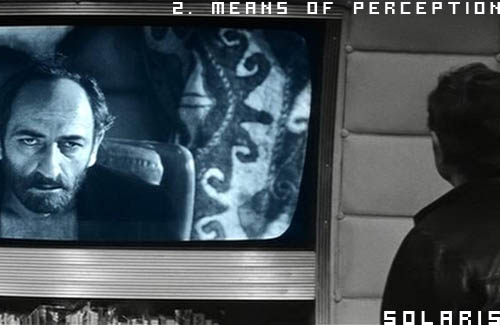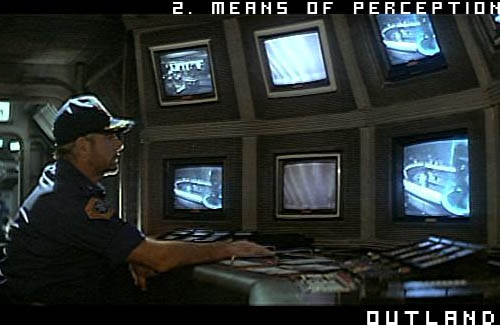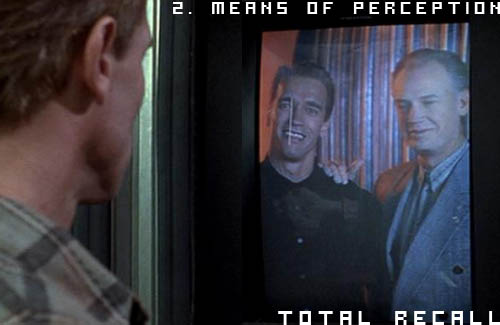 |
Solaris (1972) is an adaptation of Stanislaw Lem's novel of the same name. It is the story of a Russian research mission on a distant planet named Solaris. The researchers are attempting to communicate with an alien being whose consciousness resides within a giant ocean on the planet's surface. The protagonist is an astronaut named Kris Kelvin, who must journey to the research outpost when the success of the mission is brought into question on Earth. He discovers that the ocean is playing with the minds of the researchers by bringing their worst dreams into reality. In terms of the actual technology, the devices that facilitate communication are depicted as quite similar to existing technology of the 1970s. In fact, considering the massive leap in space travel proposed by the plot of the film, the relative obstinacy of communications technology is peculiar. Computers are not portrayed directly, but are rather suggested by a ubiquitous "technological veneer" that covers the interior of the space station. Video communication is achieved through screens that (with the exception of some bevelled corners) are identical to standard contemporary ones. Although two-way video communication was not yet realized during the early 1970s, it would not have been impressive to its audience. Special effects were minimal in the portrayal of the communications devices. It can be speculated that some green screen techniques were utilized in order to avoid the costs of such large screens, but otherwise they were treated in standard ways. On a literal level, the communications technology and computers are used in banal ways similar to the way we would use them today. However, the devices are particularly significant to the plot and to the film's themes. In terms of plot revelation, video communication serves to connect Kelvin to the fate of his friend on board the research station. Solaris questions the objectivity of reality, and asks whether it is better to accept a harsh reality, or to accept the illusions of the mind. If the mind ultimately constructs reality, what is wrong with choosing illusions - particularly if they are more appealing? This question is raised directly through the medium of video communications. |
 |
|
Outland (1981) is the story of sheriff William O'Neil who comes to work at a mining colony located on Jupiter's moon Io. A sharp increase in the number of psychotic episodes and suicides leads O'Neil to uncover a top-level conspiracy to distribute performance-enhancing drugs to the miners. O'Neil attempts to bring down the head of the mining colony, and must fight off his hired assassins. Surveillance is an important theme in the movie, and the most important role of communications technology and computers is to allow for that surveillance. Similar to Solaris, the actual portrayal of the technology is rather banal, and does not speculate on any future methods. The video equipment appears very similar to existing technology in the 1980s. Even the video resolution was similar to contemporary video surveillance. Equally familiar would have been the computer interface that O'Neil used when sending e-mail or checking his security system. The interface in both cases was a then-common text based interface on a video monitor, operated through a computer keyboard. Slightly more advanced was the use of computers to analyze the composition of a criminal's blood to discover the hidden drug content. In this case, the computer used three-dimensional images that were manipulated by the head doctor. Again, however, the interface was a standard keyboard and monitor, and the resolution of the images would have been comparable to video games from that time period. The special effects used on the video screens and computer monitors was minimal, with the only hurdle having been the three dimensional models necessary for the blood analysis scene. Surveillance presents itself as a major theme in Outland. As such, the computer technology employed in the surveillance of the colony is important to plot development. The surveillance system allows for O'Neil to observe the underhanded dealings of the colony manager, allows him to find the drug dealer, and also enhances the cat-and-mouse chase at the climax of the movie. The poor resolution of the images caught on the system carry on the visual trope in which views are always obscured, and as such they construct a threatening perception of reality. At the beginning of the 80s, culture was beginning to see the repercussions of ubiquitous surveillance made possible by computer technology, and television's power as a communications medium. Outland continues this cultural dialogue and suggests that while the technology may lead to a hyper-surveilled and paranoid world, there would always be secrets hiding in the shadows. Dennis Fanti http://www.rottentomatoes.com/ |
 |
|
Total Recall (1990) is based on the short story We Can Remember It For You Wholesale by Philip K Dick. Douglas Quaid is a construction worker who purchases a virtual holiday that is implanted into his brain. The implantation goes awry, and Quaid is plunged into a covert world in which he is a secret agent from Mars. Quaid travels to Mars in order to uncover his supposed past, and must fight the oppressive administrator of Mars in order to save its inhabitants. It is never clear whether his predicament is real, or if it is simply a part of his virtual holiday. The most important communications or computer technology is the video communications equipment. Communications equipment takes the form of video monitors that are shown ubiquitously embedded in walls, subways cars, telephone-like devices, and suitcases. For two-way communication, they appear to operate on the same principles as a telephone. Other monitors also operate using contemporary interfaces. The monitors themselves are generally bulky in design, again similar to pre-existing technology. Limited special effects were deployed in the portrayal of these devices, where only a few instances would have required green screen techniques. The rest were seemingly achieved using actual monitors. The plot revolves around the gradual recollection of Quaid's supposed memory through his adventures. Several major revelations occur through the medium of a video screen, including the both videos of his past self. However in both cases, the information transmitted through the video has been deceptive. The video operates as, and becomes a symbol for the distortion of the truth and the obfuscation of identity. As such, the video communications device is a means of perceiving oneself. The time in which this movie was made marked a moment in Western culture where the television and the screen were increasingly common in daily life. The influence of this medium was evident in the so-called MTV generation and the rise of computer technology as a part of commerce and industry. There was a great deal of cultural discussion around the screen - something that by its purpose, appears to be something it is not. Total Recall addresses this discussion by warning that the perception of reality is fundamentally challenged by the proliferation of its use.
In each of the three movies, the communications device is tied with the representation of reality, and acts as a means of perception. The actual technology used is contemporary with the making of the movie, and only make mild speculation about future advances (ie two-way video communication). In part, this is because each film is trying to make a cultural comment about the use of communications technology in their time period. And in the case of Solaris, Outland, and Total Recall, the question of reality versus perception is raised. http://en.wikipedia.org |
Means of Perception (Solaris, Outland, Total Recall) |